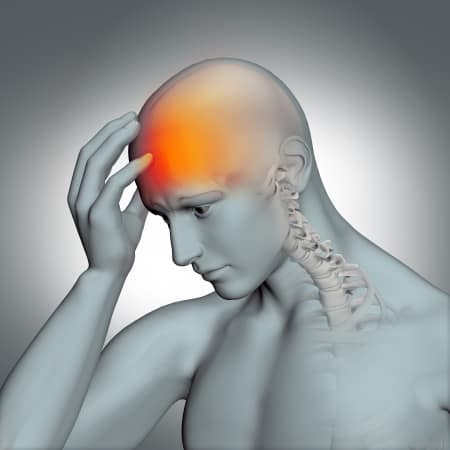Learn about brain health and nootropics to boost brain function
Scientists Find Brain Mechanism Responsible For Age-Related Memory Loss

3D male medical figure holding head in pain Research suggests that the hippocampus, an area in the brain responsible for memory, performs two complementary processes: pattern separation and pattern completion.
Pattern completion could be described as the ability to remember visiting a place when you return there a month later, even if some details have changed. On the other hand, pattern separation is remembering which conversations happened during each visit and not confusing them with each other.
As humans and rodents age, their pattern separation abilities decline . Studies have shown that this may be linked to an overactive CA3 network in the dentate gyrus in the hippocampus. Drugs that reduce this hyperactivity have increased memory performance in aged rats.
A direct study of the CA3 network’s effect on memory could help researchers develop treatments to improve age-related memory issues. Most recently, researchers studied how this CA3 network influenced the memory abilities of young and aged rats.
The researchers found that some aged rats could perform similarly to young rats in memory tasks, even though their brains showed deficits in pattern separation.
For the study, the researchers obtained four young rats (aged between 3 and 6 months) and 14 older rats (aged between 22 and 26 months). To begin, the rats underwent behavioral testing in a water maze.
They then underwent hyperdrive implant surgery so that researchers could monitor the lateral edge of their CA3 brain region.
Thereafter, they were trained for eight days to locate a submerged escape platform in a water maze tank. Every sixth time in the maze was considered a ‘probe trial’, and included no escape platform for the first 30 seconds.
The researchers used the rats’ average search proximity scores during these probe trials to calculate a learning index. The mice with a score above 240 were categorized as “aged memory-impaired”, whereas those with a learning index of less than 240 were “aged memory-unimpaired”.
The researchers then further analyzed the rats’ cognitive abilities during foraging sessions, circular track training, and further water maze tests.
As expected, they found that aged memory-impaired older rats performed worse in various tasks than younger rats and that this corresponded with hyperactivity in certain parts of the CA3 area of the hippocampus.
They also found, however, that some of the aged memory-unimpaired rats performed similarly to young rats, even though they showed signs of the same changes in their CA3 regions. Underlying mechanisms
To explain the findings, the researchers noted that in neurological conditions such as Alzheimer’s and Parkinson’s, there is little behavioral deficit until a threshold is crossed.
They said this may explain why some older rats performed similarly to younger rats, given their maze scores occurred on a continuum between the scores of the younger rats and those of the most impaired older ones.
When asked about the underlying mechanisms, Heekyung Lee , from the Knierim Lab at John Hopkins University and the primary author of the study, told Medical News Today that inhibitory neurons may play a role.
“The number of inhibitory neurons declines with age in the hippocampus. Prior work […] has shown that while inhibitory neurons in multiple subregions of the hippocampus decrease both in memory unimpaired (AU) and memory-impaired (AI) aged rats, inhibitory neurons specifically in the hilus of the dentate gyrus subregion decrease in AI, but not AU rats,” Lee explained.
“It is noteworthy that there are complex feedforward and feedback connections between the dentate gyrus and proximal CA3, two subregions that support pattern separation computations. The balance of excitation and inhibition plays an essential role in network dynamics,” she added. “One possible compensation mechanism in [aged] rats [with unimpaired memory] can be that the preservation of inhibitory neurons exclusively in the [brain’s] hilus region may be enough to overcome the age-related excitation-inhibition imbalance to favor pattern separation.” — Heekyung Lee, study author Dr. Tara Swart Bieber , neuroscientist and professor at MIT Sloan School of Management, told MNT that neuroplasticity might also play a role.
“Neuroplasticity—the ability to re-wire our brains throughout life—is likely to be the mechanism that underpins this compensation. Although harder in later life, it is possible to make new connections that can bypass pathways that have become weak. […] Also, people can fully recover after a stroke or brain surgery,” she said. The next steps
The researchers concluded that further research is warranted to understand the compensatory mechanisms in aged memory-unimpaired rats to understand how they prevent age-related cognitive decline.
When asked about future research directions, Lee said that determining different subtypes of neurons would be key for targeted therapies. “Future research to understand why inhibitory neurons are vulnerable to aging can help discover therapeutic strategies to increase inhibition in the hippocampus to help improve age-related memory issues.” — Heekyung Lee, study author “Furthermore, there are different subtypes of inhibitory neurons, and understanding the functional specificity of each subtype can allow for targeted intervention,” she added.
Dr. Bieber also said that research into lifestyle habits that may help older people manage age more efficiently could also improve understanding of these compensatory mechanisms.
When asked more generally about preventing age-related memory decline, Dr. Bieber said:
“Taking on new learning throughout your life, that is attention intense enough to change your brain, e.g., learn a new language, sport, musical instrument, etc. is the best thing you can do for your brain in adulthood.”
Read more at southfloridareporter.com